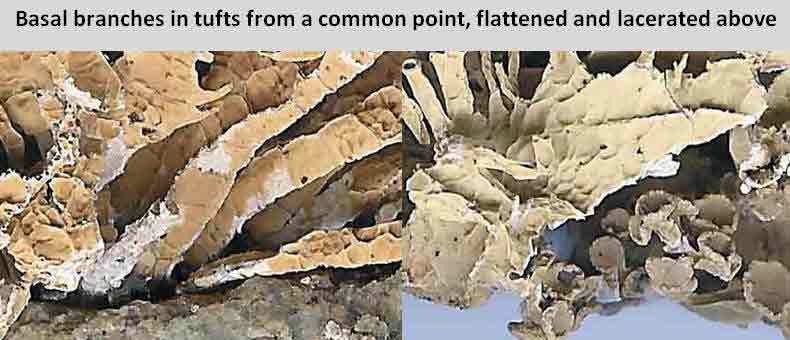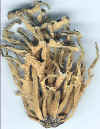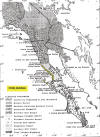|
Niebla flabellata
is a fruticose lichen widely distributed along the Pacific Coast of Baja
California. Specimens collected
on the Vizcaíno Peninsula, previously identified N. flabellata (Spjut
1996) by having only salazinic acid, are considered here to belong to the
N. spatulata
species complex as a result of Spjut et al. (2020) showing no DNA
correlation with three chemotypes, (1) salazinic acid, (2) hypoprotocetaric acid
which may also have salazinic acid, and (3) acid deficient). In BCS, the
thalli of N. spatulata with different chemotypes commonly grow near each other
in the same Niebla colony, and are often found to be closely associated
with three DNA cryptic species that have not proved distinguishable by their
morphology and chemotype. Thalli north of the peninsula, which have only
salazinic acid, are recognized as a separate species, N. flabellata, at
least perhaps at the type locality. Both species are characterized by
having relatively short and variously flattened branches arising in small
tufts from a holdfast attached to small stones on beaches. Above the thallus base, the branches become
irregular in shape, varying from nearly linear to somewhat elliptical, or almost
rotund, all of which appear with various lacerations, contortions and spine-like
branchlets. The pycnidia in N. flabellata appear less dense and less sharply defined
from the cortical surface in contrast to those of N. spatulata.
Thus, the two species complexes (N. flabellata, N. spatulata)
can be distinguished by their morphology, chemistry in part, and phytogeography.
In Baja California, N. flabellata also occurs on rock walls in narrow
coastal ravines, or on steep rocky slopes facing the ocean, arising to mesas.
Niebla flabellata is frequently encountered from Cañón San Fernando south to the Morro Santo Domingo. The most abundant occurrences
were
observed on
lava along the beach areas between Guerrero Negro and Punta Santa Rosalillita,
often as a pebble
Niebla.
In 1979, Spjut and Edson collected a 1 kg sample from Playa Altimar for cancer
research; the voucher specimen was initially identified by Mason Hale,
Desmazieria josecuervoi, the genus name later discovered by Rundel and
Bowler (1978) to be illegitimate, the species N. flabellata (Spjut 1996)
treated as a synonym of Niebla josecuervoi
by Bowler and Marsh in the Lichen Flora of the Greater Sonoran Desert. Niebla flabellata
usually occurs with other lichens, particularly
Vermilacinia
paleoderma along beaches, and N. caespitosa
on vertical rock walls in narrow canyons.
Related salazinic acid species include
Niebla josecuervoi, distinguished by the sublinear-prismatic-cylindrical
branches and N. effusa, identified by a
more rigid thallus (thicker cortex) with branches terminally flattened and fringed,
digitately arising in scorpioid manner.
Niebla limicola, similar in it irregularly widened branches,
differs by the
±
regular occurrence of short bifurcate
acicular branchlets along
primary branch margins below apex, often arising from near the base of the
thallus.
The type for
N. flabellata was collected near Puerto San Andrés. In 1985, the track
to the the former San Andrés Ranch
did not reach the coast; it terminated just beyond the ranch. A
sample collected for anti-HIV screening near Rancho San Andrés was difficult to
separate morphologically from
N. caespitosa, that is otherwise easily distinguished by its lichen substance
of divaricatic acid. The type specimen (Spjut & Marin 9073H5) was
selected from a mix sample of mostly N. caespitosa (Spjut & Marin 9073C,
divaricatic acid) and N. flabellata but included also
N. flagelliforma
(Spjut & Marin 9073F, divaricatic acid) and the type for
N. brachyura
(Spjut & Marin 9073k, hypoprotocetraric acid). In 2016, only
N. caespitosa was collected at the type location. However, a
specimen collected a few km south near Punta Santa Rosalillita, in association
with N. caespitosa and
N. flagelliforma, appeared monophyletic in
Spjut et al. (2020). In the narrowest sense, then, N. flabellata would
appear supported by DNA phylogeny as a micro-endemic species, while the
species as circumscribed by Spjut (1996) awaits further study.
For more discussion and
reference materials see Introduction to Niebla
|
















